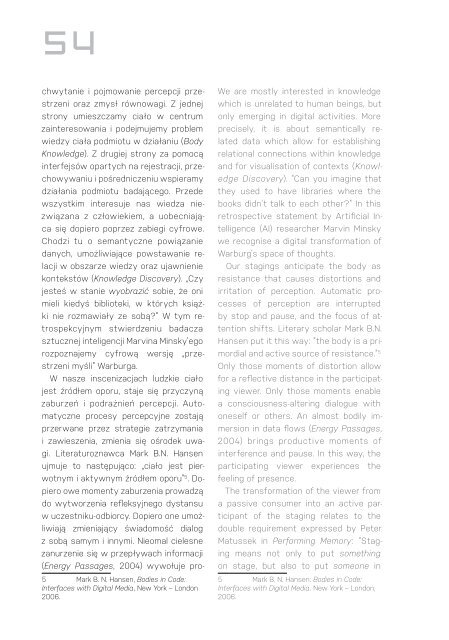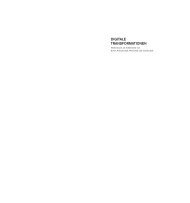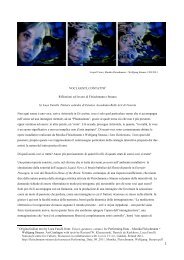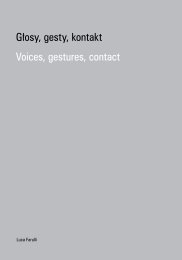Performing Data | Monika Fleischmann + Wolfgang Strauss
Performing Data is a review of Monika Fleischmann´s and Wolfgang Strauss´artistic body of work and a catalogue of their exhibition in Poland 2011. It presents works from Virtual Reality (Home of the Brain) up to Mixed Reality (Murmuring Fields) from Fluid Interface (Liquid Views) up to Floating Interface (Medienfluss) and texts by Ryszard W. Kluszczynski, Derrick de Kerkhove, Luca Farulli. Monika Fleischmann and Wolfgang Strauss from the German Fraunhofer research institute show us an intersection of the body and immaterial digital data. Immersion in data flow causes productive moments of disturbance and suspension, and consequently – a feeling of real physical presence. Fleischmann, Monika; Strauss, Wolfgang: Performing Data | Performowanie danych. National Centre for Culture, Warszawa 2011 in collaboration with Laznia CCArt, Gdańsk, Poland 2011 ISBN 978-83-61587-55-2 (en/pl) http://artline-southbaltic.eu/de/event/performing-data/
Performing Data is a review of Monika Fleischmann´s and Wolfgang Strauss´artistic body of work and a catalogue of their exhibition in Poland 2011. It presents works from Virtual Reality (Home of the Brain) up to Mixed Reality (Murmuring Fields) from Fluid Interface (Liquid Views) up to Floating Interface (Medienfluss) and texts by Ryszard W. Kluszczynski, Derrick de Kerkhove, Luca Farulli.
Monika Fleischmann and Wolfgang Strauss from the German Fraunhofer research institute show us an intersection of the body and immaterial digital data. Immersion in data flow causes productive moments of disturbance and suspension, and consequently – a feeling of real physical presence.
Fleischmann, Monika; Strauss, Wolfgang: Performing Data | Performowanie danych. National Centre for Culture, Warszawa 2011 in collaboration with Laznia CCArt, Gdańsk, Poland 2011 ISBN 978-83-61587-55-2 (en/pl) http://artline-southbaltic.eu/de/event/performing-data/
You also want an ePaper? Increase the reach of your titles
YUMPU automatically turns print PDFs into web optimized ePapers that Google loves.
chwytanie i pojmowanie percepcji przestrzeni<br />
oraz zmysł równowagi. Z jednej<br />
strony umieszczamy ciało w centrum<br />
zainteresowania i podejmujemy problem<br />
wiedzy ciała podmiotu w działaniu (Body<br />
Knowledge). Z drugiej strony za pomocą<br />
interfejsów opartych na rejestracji, przechowywaniu<br />
i pośredniczeniu wspieramy<br />
działania podmiotu badającego. Przede<br />
wszystkim interesuje nas wiedza niezwiązana<br />
z człowiekiem, a uobecniająca<br />
się dopiero poprzez zabiegi cyfrowe.<br />
Chodzi tu o semantyczne powiązanie<br />
danych, umożliwiające powstawanie relacji<br />
w obszarze wiedzy oraz ujawnienie<br />
kontekstów (Knowledge Discovery). „Czy<br />
jesteś w stanie wyobrazić sobie, że oni<br />
mieli kiedyś biblioteki, w których książki<br />
nie rozmawiały ze sobą?” W tym retrospekcyjnym<br />
stwierdzeniu badacza<br />
sztucznej inteligencji Marvina Minsky’ego<br />
rozpoznajemy cyfrową wersję „przestrzeni<br />
myśli” Warburga.<br />
W nasze inscenizacjach ludzkie ciało<br />
jest źródłem oporu, staje się przyczyną<br />
zaburzeń i podrażnień percepcji. Automatyczne<br />
procesy percepcyjne zostają<br />
przerwane przez strategie zatrzymania<br />
i zawieszenia, zmienia się ośrodek uwagi.<br />
Literaturoznawca Mark B.N. Hansen<br />
ujmuje to następująco: „ciało jest pierwotnym<br />
i aktywnym źródłem oporu” 5 . Dopiero<br />
owe momenty zaburzenia prowadzą<br />
do wytworzenia refleksyjnego dystansu<br />
w uczestniku-odbiorcy. Dopiero one umożliwiają<br />
zmieniający świadomość dialog<br />
z sobą samym i innymi. Nieomal cielesne<br />
zanurzenie się w przepływach informacji<br />
(Energy Passages, 2004) wywołuje pro-<br />
5 Mark B. N. Hansen, Bodies in Code:<br />
Interfaces with Digital Media, New York – London<br />
2006.<br />
We are mostly interested in knowledge<br />
which is unrelated to human beings, but<br />
only emerging in digital activities. More<br />
precisely, it is about semantically related<br />
data which allow for establishing<br />
relational connections within knowledge<br />
and for visualisation of contexts (Knowledge<br />
Discovery). “Can you imagine that<br />
they used to have libraries where the<br />
books didn’t talk to each other?” In this<br />
retrospective statement by Artificial Intelligence<br />
(AI) researcher Marvin Minsky<br />
we recognise a digital transformation of<br />
Warburg’s space of thoughts.<br />
Our stagings anticipate the body as<br />
resistance that causes distortions and<br />
irritation of perception. Automatic processes<br />
of perception are interrupted<br />
by stop and pause, and the focus of attention<br />
shifts. Literary scholar Mark B.N.<br />
Hansen put it this way: “the body is a primordial<br />
and active source of resistance.” 5<br />
Only those moments of distortion allow<br />
for a reflective distance in the participating<br />
viewer. Only those moments enable<br />
a consciousness-altering dialogue with<br />
oneself or others. An almost bodily immersion<br />
in data flows (Energy Passages,<br />
2004) brings productive moments of<br />
interference and pause. In this way, the<br />
participating viewer experiences the<br />
feeling of presence.<br />
The transformation of the viewer from<br />
a passive consumer into an active participant<br />
of the staging relates to the<br />
double requirement expressed by Peter<br />
Matussek in <strong>Performing</strong> Memory: “Staging<br />
means not only to put something<br />
on stage, but also to put someone in<br />
5 Mark B. N. Hansen: Bodies in Code:<br />
Interfaces with Digital Media. New York – London,<br />
2006.







